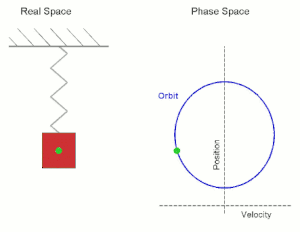Simple harmonic motion
Simple harmonic oscillator
Main article: Simple harmonic motion
A simple harmonic oscillator is an oscillator that is neither driven nor damped. It consists of a mass m, which experiences a single force, F, which pulls the mass in the direction of the point x=0 and depends only on the mass's position x and a constant k. Balance of forces (Newton's second law) for the system isThe velocity and acceleration of a simple harmonic oscillator oscillate with the same frequency as the position but with shifted phases. The velocity is maximum for zero displacement, while the acceleration is in the opposite direction as the displacement.
The potential energy stored in a simple harmonic oscillator at position x is
From Wikipedia, the free encyclopedia
In mechanics and physics, simple harmonic motion is a type of periodic motion where the restoring force is directly proportional to the displacement. It can serve as a mathematical model
of a variety of motions, such as the oscillation of a spring. In
addition, other phenomena can be approximated by simple harmonic motion,
including the motion of a simple pendulum as well as molecular vibration.
Simple harmonic motion is typified by the motion of a mass on a spring
when it is subject to the linear elastic restoring force given by
Hooke's Law. The motion is sinusoidal in time and demonstrates a single
resonant frequency. In order for simple harmonic motion to take place,
the net force of the object at the end of the pendulum must be
proportional to the displacement.Simple harmonic motion provides a basis for the characterization of more complicated motions through the techniques of Fourier analysis.
Contents
Introduction

Simple harmonic motion shown both in real space and phase space. The orbit
is periodic. (Here the velocity and position axes have been reversed
from the standard convention in order to align the two diagrams)
Mathematically, the restoring force F is given by
For any simple harmonic oscillator:
- When the system is displaced from its equilibrium position, a restoring force which resembles Hooke's law tends to restore the system to equilibrium.
As long as the system has no energy loss, the mass will continue to oscillate. Thus, simple harmonic motion is a type of periodic motion.
Dynamics of simple harmonic motion
For one-dimensional simple harmonic motion, the equation of motion, which is a second-order linear ordinary differential equation with constant coefficients, could be obtained by means of Newton's second law and Hooke's law.Therefore,
Using the techniques of differential calculus, the velocity and acceleration as a function of time can be found:
Energy of simple harmonic motion
The kinetic energy K of the system at time t isExamples
Mass on a spring
A mass m attached to a spring of spring constant k exhibits simple harmonic motion in closed space. The equationUniform circular motion
Simple harmonic motion can in some cases be considered to be the one-dimensional projection of uniform circular motion. If an object moves with angular speed ω around a circle of radius r centered at the origin of the x-y plane, then its motion along each coordinate is simple harmonic motion with amplitude r and angular frequency ω.Mass on a simple pendulum

The motion of an undamped Pendulum approximates to simple harmonic motion if the amplitude is very small relative to the length of the rod.
This approximation is accurate only in small angles because of the expression for angular acceleration α being proportional to the sine of position:
ComplexSinInATimeAxe
ComplexSinInATimeAxe.gif (550 × 400 pixels, file size: 201 KB, MIME type: image/gif, looped, 49 frames, 7.8 s)

























0 comments:
Post a Comment